903.9 General Information Signs: Difference between revisions
m →Table 903.9.23 National Known, National Prominent Sites: Per TS, added Ulysses S. Grant Nat'l Historic Site to listing |
|||
| Line 689: | Line 689: | ||
|Ulysses S. Grant National Historic Site | |Ulysses S. Grant National Historic Site | ||
|- | |- | ||
|Wilson's Creek | |Wilson's Creek National Battlefield Park | ||
|- | |- | ||
|Winston Churchill Memorial | |Winston Churchill Memorial | ||
Revision as of 10:46, 18 July 2017
903.9.1 Sizes of General Information Signs (MUTCD Section 2H.01)
Standard. Except as provided in EPG 903.2.21, the sizes of General Information signs that have a standardized design shall be as shown in Table 903.9.1.
Support. EPG 903.2.21 contains information regarding the applicability of the various columns in Table 903.9.1.
Option. Signs larger than those shown in Table 903.9.1 may be used (see EPG 903.2.21).
Table 903.9.1 Guide Sign Sizes
| Sign | Sign Designation | EPG Article | Conventional Road (in. x in.) | Freeway/Expressway (in. x in.) | ||
|---|---|---|---|---|---|---|
| Single Lane | Multi-Lane | Oversized | Mainline & Ramps | |||
| Emergency Reference | D10-5 | 903.9.4 | - | - | - | 18 X 60 |
| Auto Tour | M17 Series | 903.9.5 | Varies | Varies | - | Varies |
| Acknowledgement | I9-1, I9-1P, I9-1a, I9-1aP, I9-2, I9-2P, I9-3 | 903.9.6 | Varies | Varies | - | Varies |
| Airport | D4-10 | 903.9.7 | Var X 36 | - | - | - |
| Business District | D4-15 | 903.9.8 | 36 X 18 | 36 X 18 | - | - |
| Industrial Park | D4-16 | 903.9.8 | 48 X 36 | 48 X 36 | - | - |
| City Limit | I4-1, I4-1a, I4-1P, I4-2, I4-2a, I4-2b, I4-2c, I4-2P | 903.9.9 | Varies | Varies | - | Varies |
| Town | I5-1, I5-1P | 903.9.9 | Varies | - | - | - |
| County Line | I6 Series | 903.9.9 | Varies | Varies | - | Varies |
| Custom City Limit | I4-1a, I4-2b, I4-2c | 903.9.11 | Varies | Varies | - | Varies |
| Custom County Limit | I6-1a | 903.9.11 | Var X 48 | Var X 48 | - | Var X 48 |
| Accomplishment | I4-1P, I4-2P, I5-1P, I6-1P | 903.9.12 | Varies | Varies | - | Varies |
| Welcome To (for cities) | - | 903.9.13 | Varies | Varies | - | Varies |
| Missouri State Line | I2-1 | 903.9.14 | 36 X 18 | 72 X 36 | - | 72 X 36 |
| Missouri Welcomes You | I2-2, I2-3 | 903.9.14 | 96 X 48 | 96 X 48 | - | 144 X 74 |
| Welcome Center (for state line only) | I2-3P | 903.9.14 | - | - | - | 144 X 36 |
| Stream | I3-1, I3-1a | 903.9.15 | Varies | Varies | - | Varies |
| Transportation | I-5, I-7 | 903.9.16 | 24 X 24 | 24 X 24 | - | 30 X 30 |
| Veterans | - | 903.9.19 | Varies | Varies | - | Varies |
| College Generator | E12-1, E12-2, E12-2a, E12-3, E12-3a | 903.9.20.1 | - | - | - | Varies |
| College Emblem | E12-4, E12-4a, E12-5, E12-5a, E12-6, E12-6a | 903.9.20.2 | - | - | - | Varies |
| College Destination | E12-1a | 903.9.20.3 | Varies | Varies | - | - |
| Correctional Center | - | 903.9.21 | Varies | Varies | - | Varies |
| Lewis and Clark | M17-2a | 903.9.22 | 24 X 30 | 24 X 30 | - | 24 X 30 |
903.9.2 General Information Signs (I Series) (MUTCD Section 2H.02)
Support. Of interest to the traveler, though not directly necessary for guidance, are numerous kinds of information that can properly be conveyed by General Information signs or miscellaneous information signs. They include such items as Missouri State line (I2-1), City limit (I4-1, I4-2), town signs (I5-1), County line (I6-1)and stream names (I3-1).
Option. The pictograph of a political jurisdiction (such as a state, county, or municipal corporation) may be displayed on a political boundary General Information sign.
Standard. If used, the height of a pictograph on a political boundary General Information sign shall not exceed two times the height of the upper-case letters of the principal legend on the sign. The pictograph shall comply with the provisions of EPG 903.2.14.
903.9.3 Miscellaneous Information Signs (MUTCD Section 2H.04)
Support. Miscellaneous information signs are used to point out geographical features, such as rivers and summits and other jurisdictional boundaries.
Option. Miscellaneous information signs may be used if they do not interfere with signing for interchanges or other critical points.
Guidance. Miscellaneous information signs should not to be installed unless there are specific reasons for orienting the travelers or identifying control points for activities that are clearly in the public interest. If Miscellaneous information signs are to be of value to the traveler, they should be consistent with other guide signs in design and legibility. On all such signs, the design should be simple and dignified, without any tendency toward flamboyant advertising and in general compliance with other signing.
903.9.4 Emergency Reference Markers (D10-5)

Support. Emergency Reference Markers (D10-5) are used to assist travelers in estimating their progress, provide a means for identifying the location of emergency incidents and traffic crashes, and to aid in highway maintenance and servicing.
Standard. Emergency Reference Markers (D10-5) shall be placed on Interstates (instead of traditional mile marker signs) at two tenth of a mile intervals. An Emergency Reference Marker shall not be installed if it cannot be set within 200 ft. of its exact location.
Every attempt shall be made to install Emergency Reference Markers, even if this requires special mounting designs on walls, bridges or concrete median barrier.
Emergency Reference Markers shall be vertical panels having green backgrounds with white numerals, letters and borders, except for the route shield, which shall be the standard color and shape. The top line shall consist of the cardinal direction for the roadway. The second line shall consist of the applicable route shield for the roadway. The third line shall identify the mile reference for the location and the bottom line of the Emergency Reference Marker shall give the tenth of a mile reference for the location displaying the decimal point.
Emergency Reference Markers shall have a minimum mounting height of 4 ft. to the bottom of the sign according to the mounting height requirements of EPG 903.2.26 Location Standardization and per details found in Standard Plan 903.03.
The distance numbering shall be continuous for each route within the state, except where overlaps occur (see EPG 903.8.32). Where routes overlap, Emergency Reference Marker continuity shall be established for the route of higher classification. If two routes of the same class overlap each other, the route with the lower designation takes precedent unless that route overlaps for a only short segment.
Guidance. The route selected for continuity of distance numbering should also have continuity in interchange exit numbering (see EPG 903.8.32). On a route without Emergency Reference Marker continuity, the first Emergency Reference Marker beyond the overlap should indicate the total distance traveled on the route so that travelers will have a means of correlating their travel distance between Emergency Reference Markers with that shown on their odometer.
Standard. The distance measurement shall increase in the northbound and eastbound directions of travel. Emergency Reference Markers for southbound or westbound roadways shall be set at locations directly opposite to and displaying the same distance measurement as the Emergency Reference Marker for the northbound or eastbound roadways.
Guidance. The zero-distance should begin at the south and west state lines, or at the south and west terminus points where routes begin within a state.
Standard. Except as provided in the option below Emergency Reference Markers shall be installed on the right side of the roadway.
Option. Where conditions limit or restrict the use of Emergency Reference Markers on the right side of the roadway, they may be installed in the median. Emergency Reference Markers may be installed back-to-back if the median location is warranted. Emergency Reference Markers may be installed on non-interstate freeways and expressways under the following conditions:
- 1. Written support from the local response agency must first be obtained.
- 2. A logical beginning and ending point must be chosen. Examples of logical beginning or ending points include state boundaries, transitions from two to four lanes, or major intersections. District borders, county lines or construction project limits are not logical beginning and ending points.
- 3. All districts along the route must be involved in the decision to install Emergency Reference Markers on a route to ensure consistency of application.
Guidance. Emergency Reference markers should not be installed on routes which are likely to change in length due to future realignments. Roadway realignments would require the replacement of Emergency Reference Markers in the future to correct the distance measurement displayed on these signs.
903.9.5 Auto Tour Route Signs (M17 series) (MUTCD Section 2H.07)
 |
 |
 |
 |
 |
 | |
 |
 |
 |
 |
 |
 | |
Support. At times individuals or groups who want historic recognition for a road or section of a road approach MoDOT. This policy defines what is needed and by whom before consideration can be given to signing an historic route.
Standard. The Commission will consider marking of an historic road when the following provisions have been met:
A. The road has been recognized by an organized federal or state group as a road having significant historical importance to the transportation system.
B. There shall be an organized group that sponsors and determines the exact route of the historical road.
C. There shall be a minimum length of 50 miles required for a historic road. Short disconnected segments are discouraged.
D. Any part of the Commission-maintained system shall be limited to a maximum of three concurrent historic route and/or trail designations.
E. There shall be an agreement between the sponsoring group and the Commission to define the responsibilities of each.
The agreement shall contain the following provisions:
A. The Commission shall coordinate the fabrication of the approved historic route signs and install and maintain these signs on the approved segments of the historic route within the Commission's current highway system.
B. The sponsoring group shall install and maintain the approved historic route signs on those portions of the approved historic route, which are not a part of the Commission's current highway system. These installations will be at no cost to the Commission.
C. The sponsoring group shall reimburse the Commission for the cost of fabricating the approved historic route signs regardless of where the signs are placed. The sponsoring group shall also reimburse the Commission for the cost of installing and maintaining those signs, which are placed on the Commission's current highway system.
D. The approved historic signs shall be mounted as an independent confirmation marker at locations agreed upon by the Commission and the sponsoring group.
If the historic road crosses a state line, there must be agreement with the adjoining state or states on the signing and the routing of the historic route. If agreements with the other states cannot be reached the historic signing shall end at the last intersection in Missouri.
If approved, Auto Tour Route signs shall not be installed on freeways or expressways, except as necessary to provide continuity between discontinuous segments of conventional roadways that are designated as auto tour routes, for which the freeway or expressway provides the only connection between the segments. If installed on freeways or expressways, Auto Tour Route signs shall be installed as independent trailblazer assemblies and shall not be installed with other Route signs or confirmation assemblies or on guide signs. If installed on freeways or expressways, Auto Tour Route trailblazer assemblies shall be installed at less frequent intervals than route confirmation assemblies.
Support. Auto Tour Route signs are informational signs, plaques, or shields designed to provide travelers with guidance in following an auto tour route of particular cultural, historical or educational significance.
Signed auto tour routes are used to generally follow the historical route of a trail. There are several approved trails or overlays that follow state maintained routes. Approved trail overlays are:
A. Lewis and Clark Trail (M17-2)
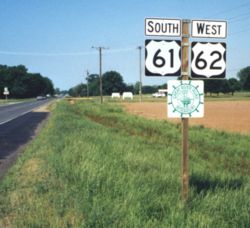
B. Great River Road (M17-6)
C. Historic 66 (M17-8, M17-8a)
D. Santa Fe Trail (M17-4)
E. Oregon Trail (M17-3)
F. Trail of Tears (M17-5)
G. Avenue of the Saints (M17-9)
H. Mississippi River Trail (MRT) or bike trail (M17-7)
I. Pony Express (M17-10)
J. California Trail (M17-11)
Standard. The State Traffic Engineer shall approve signing for any additional trails. The general principles for signing trail or overlays are:
A. Where the Trail or overlay continues over a marked route at a junction with another numbered or lettered route and no turn is involved, the Trail Route Marker shall be mounted at the lower-most portion of the confirmation assembly on the far side of the intersection. This will require a total of two markers per intersection with numbered or lettered routes.
B. Where the Trail or overlay makes a turn at a junction, there shall be a separate advance turn assembly consisting of the Trail Route Marker and Advance Turn Arrow black on white series sign beneath it. The Trail Route Marker shall be added to the confirmation assembly beyond the junction. The advance turn assembly shall be located between the junction assembly and destination sign.
C. If two or more trails or overlays run concurrently on a route, the trail or overlay confirmation assemblies shall be erected on a separate post after the route confirmation. Cardinal Direction plaques shall not be used with trails or overlay route markers. The AUTO TOUR (M17-1) auxiliary sign shall be used in combination with the Santa Fe (M17-4), Trail of Tears (M17-5), and Oregon Trail (M17-3) markers.
Guidance. If shields or other similar signs are used to provide route guidance in following an auto tour route, they should be designed in accordance with the sizes and other design principles for route signs, such as those described in EPG 903.7.10 through EPG 903.7.12.
Typically exclusive to the Lewis and Clark Trail (M17-2) marker, signing should be placed on the Advance Guide Sign where the Lewis and Clark trail crosses an expressway or freeway.
Option. The Lewis and Clark Trail marker may be placed either on the Advance Guide sign if there is adequate green space at the top of the sign or mounted to hang below the Advance Guide Sign.
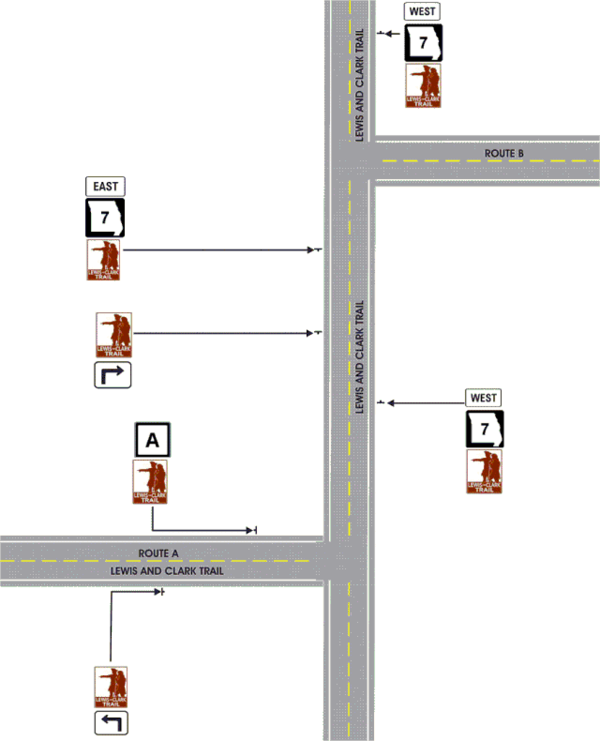
903.9.6 Acknowledgment Signs (I9-1, I9-2, I9-2P, I9-3) (MUTCD Section 2H.08)
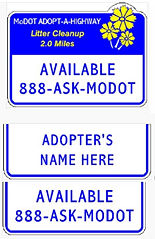 |
 |
 |
Support. Acknowledgment signs are a way of recognizing a company, business, or volunteer group that provides a highway-related service. Acknowledgment signs include, but are not limited to, sponsorship signs for adopt-a-highway litter removal programs, maintenance of a parkway or interchange, and other highway maintenance or beautification sponsorship programs.
Refer to EPG 141.8 Sponsorship Programs for more information on MoDOT's Sponsorship Policy.
Guidance. Refer to EPG 171 Maintenance Policy and Operations for acknowledgment sign program policy.
Standard. Because regulatory, warning, and guide signs have a higher priority, acknowledgment signs shall only be installed where adequate spacing is available between the acknowledgment sign and other higher priority signs. Acknowledgment signs shall not be installed in a position where they would obscure the road users’ view of other traffic control devices.
Acknowledgment signs shall not be installed at any of the following locations:
A. On the front or back of, adjacent to, or around any other traffic control device, including traffic signs, highway traffic signals and changeable message signs;
B. On the front or back of, adjacent to, or around the supports or structures of other traffic control devices, or bridge piers; or
C. At key decision points where a road user’s attention is more appropriately focused on other traffic control devices, roadway geometry or traffic conditions, including exit and entrance ramps, intersections, grade crossings, toll plazas, temporary traffic control zones and areas of limited sight distance.
Guidance. The minimum spacing between acknowledgment signs and any other traffic control signs, except parking regulation signs, should be:
A. 150 ft. on roadways with speed limits of less than 30 mph,
B. 200 ft. on roadways with speed limits of 30 to 45 mph, and
C. 500 ft. on roadways with speed limits greater than 45 mph.
If the placement of a newly-installed higher-priority traffic control device, such as a higher-priority sign, a highway traffic signal or a temporary traffic control device, conflicts with an existing acknowledgment sign, the acknowledgment sign should be relocated, covered or removed.
Option. Acknowledgment signs may have their own designs and may also use their own pictograph and/or a brief jurisdiction-wide program slogan as part of any portion of the acknowledgment sign, provided that the signs comply with the provisions for shape, color, and lettering style in this article and in EPG 903.2 Extent of Signing.
Guidance. Acknowledgment signs should clearly indicate the type of highway services provided by the sponsor.
Standard. Acknowledgment signs shall comply with the following provisions:
A. Neither the sign design nor the sponsor acknowledgment logo shall contain any contact information, directions, slogans (other than a brief jurisdiction-wide program slogan, if used), telephone numbers, or internet addresses, including domain names and uniform resource locators (URL);
B. Except for the lettering, if any, on the sponsor acknowledgment logo, all of the lettering shall be in upper-case letters;
C. In order to keep the main focus on the highway-related service and not on the sponsor acknowledgment logo, the area reserved for the sponsor acknowledgment logo shall not exceed 1/3 of the total area of the sign and shall be a maximum of 8 sq. ft., and shall not be located at the top of the sign;
D. The entire sign display area shall not exceed 24 sq. ft.;
E. The sign shall not contain any messages, lights, symbols or trademarks that resemble any official traffic control devices;
F. The sign shall not contain any external or internal illumination, light-emitting diodes, luminous tubing, fiber optics, luminescent panels, or other flashing, moving or animated features; and
G. The sign shall not distract from official traffic control messages such as regulatory, warning, or guidance messages.
Guidance. In spring of 2012 the design of Adopt-A-Highway signs changed from an all blue background (I9-1) to a blue and white background with an interchangeable plaque system (I9-1a and I9-1aP). This plaque system is designed to allow Adopt-A-Highway signs to remain standing when adopters enter and leave the program. For new adoptions, the basic sign has a message of “AVAILABLE 888-ASK-MODOT” (I9-1a) and the plaque bearing the adopter’s name or message (I9-1aP) is installed over this message. When an adopter ceases participation in the program, the plaque should be removed, revealing the “available” message.
Additionally, “AVAILABLE 888-ASK-MODOT” plaques (I9-1P) may be placed on the older style signs (I9-1) when an adopter stops participating if the existing sign still has some remaining service life. Once a new adopter chooses this section of roadway, the “available” plaque (I9-1P) may be changed out with a new plaque bearing the adopters name or message (I9-1aP).
903.9.7 Airport Sign (D4-10)
 |
Support. The D4-10 airport signs are intended for small public airfields or airports.
Option. The Airport (D4-10) signs may be mounted back-to-back on the same post(s) or erected separately.
Third order signing may be provided for small airports that provide limited, regularly scheduled commercial service.
Standard. First order signing shall only be provided for public airports or flying fields that do not offer commercial flights. If the first order signing location is at an interchange, only ramp terminal signing will be provided. Airport signing shall not be provided for privately owned airports or flying fields.
Use of the Airport (I-5) Symbol sign is reserved for guidance to airports offering commercial service and shall not be used to provide guidance for airports that do not provide commercial flights.
903.9.8 BUSINESS DISTRICT and INDUSTRIAL PARK Signs (D4-15, D4-16)
 |
 |
Option. The BUSINESS DISTRICT (D4-15) sign may be erected on a highway within the city limits at the principal intersection leading to the central business district.
Standard. If a route passes through the central business district, this sign shall not be used.
Option. The INDUSTRIAL PARK (D4-16) sign may be erected on a highway within the city limits at the principal intersection leading to the central industrial park when truck traffic tends to get lost or miss turns.
Guidance. If used, the INDUSTRIAL PARK sign should be installed at first order signing for the most direct path.
Standard. If a route passes through the industrial park, this sign shall not be used.
903.9.9 City/County Limit Signs (I4, I5, I6 Series)
 |
 | |
 |
Standard. The City Limit (I4 series) signs shall be erected at the city limit of each incorporated area, at the point where the city limit crosses the right of way.
The population of the I4 series signs shall be according to the latest U.S. Census published by the United States Department of Commerce or in accordance with a special census by the governor.
The population shall not be shown on a Town sign.
The County Line (I6 series) signs shall be erected on all routes at county lines.
Guidance. The County Line sign should not be erected at the state line.
Support. See EPG 903.17 Typical Signing Applications of City Limit signs.
Option. The Town sign may be erected at the entrance to an unincorporated area.
A Speed Limit sign may be mounted above the Town sign.
Town Signs (I5-1) may be installed at the approximate entrance of an unincorporated town, similar to a city limit sign. Towns eligible for signing are those that the traveling public would view or recognize as an organized town as they pass through the area. These towns would typically have businesses, community centers or other non-residential structures that are visible from the highway, in addition to their residential areas. They would also be significant enough to typically justify a reduction in the posted speed limit and/or be considered as a destination on highway signs. Eligible towns are typically structured enough to also have some form of governing board or council.
Residential neighbor developments or subdivisions are not to be considered towns that would qualify for highway signing. Regions that once were recognized by the traveling public as a town but now have very little or no community recognizable features would no longer be eligible for signing. Existing Community boards installed for regions that are no longer eligible for signing shall remain in place until the end of their service life.
903.9.10 Special Supplemental Signing
Support. Special supplemental signing policies contained in EPG 903.9.11 and EPG 903.9.12 refer to signs that are either modifications of existing MoDOT signs or special guide signs that have been approved for use. In many cases these signs are provided by MoDOT and have a participation fee associated with the fabrication, installation and maintenance of these special supplementary signs.
Guidance. Care should be taken when considering adding supplemental signs to make sure they do not interfere with or distract from regulatory, warning or guide signs. Sufficient spacing, at least 800 ft. on freeways or expressways, should be allowed for drivers to be able to read and comprehend the sign messages.
903.9.11 Custom City Limit and Custom County Line Signs (I4-1a, I4-2b, I4-2c, I6-1a)
 |
 |
 |
 |
Support. Many cities and counties want to enhance their identity and presence to the traveling public. A way to do this is by placing customized city or county limit signs in lieu of the MoDOT standard sign. Standards have been developed, according to the MUTCD, as to what the signs will look like and what is allowed to be added to customize the signs. Custom signs are not required at city or county limits on the state system.
Incorporated communities are permitted to request that custom city limit signs be installed on the state system.
Standard. Any custom sign not conforming to this policy shall be removed.
MoDOT shall fabricate customized signs, for consistency, according to the standards described below. Graphics or messages requested by the city or county shall have the approval of the department prior to fabrication.
The signs shall be white legend on a green background. The signs shall be made of reflectorized material according to MoDOT standards. Lettering on the signs shall be of the approved size and style as contained in the MUTCD for the type of facility where the signs will go.
The left side of the signs shall be the standard message used on MoDOT-supplied city or county limit signs that is the wording “City Limit”, the name of the city and the population or “Entering” and name of county. The right side of the sign, in a square area, dependent on the height of the sign, shall be where the city or county will be allowed to put their custom legend. The use of a city or county logo or emblem shall be allowed. Logos of individual organizations shall not be allowed.
When a city or county elects to use a customized limit sign, MoDOT shall replace the standard sign with the custom sign. If there is a need for a speed limit sign, the speed limit sign shall be installed the same as if a standard city limit sign were used.
A participation fee shall be paid for by the city/county which will include all cost for fabrication, installation, and maintenance of the signs. Refer to EPG 903.16 for contract process.
Lighting of these signs shall not be allowed.
Guidance. The TR-15 contract should be executed between the city or county and MoDOT before the sign is installed.
The legend of the sign should be simple, dignified and void of any commercial advertising.
Landscaping around any of these signs should be coordinated and reviewed by the department’s roadside management personnel.
903.9.12 City and County Accomplishment Plaques (I4-1P, I4-2P, I5-1P, I6-1P)
 |
Support. Many cities and counties want to announce the academic and/or athletic accomplishments of their local schools.
Option. A city may elect to recognize the academic and athletic accomplishments of their schools by placing a maximum of three supplemental plaques, 1 ft. tall, under the custom or standard city limit sign and a county may place a maximum of two supplemental plaques, 1 ft. tall under the custom or standard county line sign.
In order to accommodate legends with a sizeable amount of text, several plaques may be used for the message. See Fig. 903.9.12.
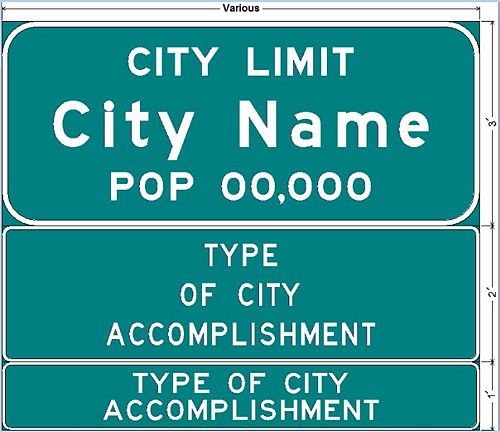
Standard. Supplemental plaques shall be allowed under city/county limit or custom city/county signs. The city or county shall select the accomplishments to be displayed with MoDOT’s concurrence.
One accomplishment shall be displayed on one plaque, except as provided herein.
Each plaque shall be variable by 12 in. with a maximum width of 60 in. for flat sheet and 120 in. for structural.
If a new accomplishment plaque is requested and the maximum amount already exists, the city or county shall determine which existing plaque gets removed, if any.
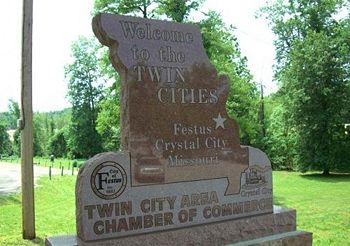
The plaques shall be white legend on green background. All minimum ground clearance and breakaway requirements shall be followed. No commercial advertising or business logos shall be permitted.
The participation fee shall be paid for by the city or county. Department forces shall fabricate, install and maintain these plaques.
Guidance. When several plaques are used to accommodate legends with a sizeable amount of text the sum of square footage of 3 supplemental plaques is not to be exceeded for cities and 2 supplemental plaques for counties.
903.9.13 Welcome To Signs for Cities
Option. Cities may place Welcome To signs on MoDOT right of way to welcome visitors to their city when their city limits encompass the intersection.
Welcome To signs may be made retroreflective.
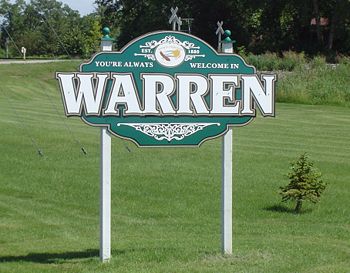
Standard. Welcome To signs shall fit on one or two MoDOT breakaway sign posts (wood, PSST, pipe, structural) as a ground mounted sign only. Welcome To signs shall not be mounted overhead or on bridge structures, i.e. girders, columns abutment walls, etc.
Welcome To signs shall not be illuminated electrically.
Welcome To signs shall not contain advertisement of any kind.
Welcome To signs shall not provide directional guidance by displaying destinations with or without arrows.
A TR-42 agreement shall be executed before a Welcome To sign is installed.
Guidance. Welcome To signs should be installed in a location that does not interfere with normal highway signs and possess the least possible threat to the motorist should they leave the roadway.
The district should consider issuing a permit that would be tied to the installation of Welcome To signs so as to address details that are not covered in the TR-42 (such as locating utilities and traffic control responsibilities).
Support. The content and design of the sign face is up to the city. It is recommended the signs be retroreflective so they are visible at night and have the same appearance at night as they do during the day.
Guidance for Welcome To monuments can be found in EPG 941.5.
903.9.14 State Line Signs (I2-1, I2-2, I2-3, I2-3P)
 |
 |
 |
Standard. The MISSOURI STATE LINE (I2-1) sign shall be erected at the state line on all lettered routes.
The large Welcome to Missouri (I2-3) sign shall be erected at or near the state line on numbered routes where the traffic volume is 1,000 AADT or greater. The Welcome to Missouri Welcome Center (I2-3P) plaque shall be installed below a Welcome to Missouri (I2-3) sign on interstates when there is a welcome center located downstream from the state line.
The smaller sign (I2-2) shall be erected at or near the state line on numbered routes where the traffic volume is less than 1,000 AADT.
Guidance. At locations where it may be impractical to erect the Welcome to Missouri sign at or near the state line, the MISSOURI STATE LINE sign should be used. At such locations the Welcome to Missouri sign shall be erected in addition to the MISSOURI STATE LINE sign, preferable within ¼ mile of the state line.
Option. The MISSOURI STATE LINE sign may be erected on other routes where it is impractical to use the Welcome to Missouri sign.
903.9.15 Stream Name Signs (I3-1)

Guidance. Stream Name (I3-1) signs should be erected at all bridge type structures, excluding box culverts, on the interstate and all numbered routes where the official name can be determined. If the name of the stream cannot be determined, the Stream Name sign should be omitted.
Standard. Stream Name signs shall not be installed on letter routes.
In those cases where signing for a body of water, which is a part of or connected to a lake, names (such as branch, river, creek, etc.) shall be incorporated in the sign as required. A typical example of this type of signing would be “LAKE OF THE OZARKS-OSAGE RIVER”.
903.9.16 Transportation Signs (I-5, I-7, E11-1)
 |
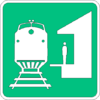 |
 |
Option. Guide signs for commercial service airports may be provided from the nearest Interstate, or other freeway intersection directly to the airport, normally not to exceed 15 miles. The Airport (I-5) symbol sign along with a supplemental plaque may be used to indicate the specific name of the airport. An Airport symbol sign, with or without a supplemental name plaque or the word AIRPORT, and an arrow may be used as a trailblazer.
Standard. Adequate trailblazer signs shall be in place prior to installing the airport guide signs.
Support. Location and placement of all airport guide signs depends upon the availability of longitudinal spacing on highways.
Standard. When a sign is used to display a safety or transportation-related message, the display format shall not be of a type that would be considered similar to advertising displays. Messages and symbols that resemble any official traffic control device shall not be used on safety or transportation-related message signs.
The Amtrak Station (I-7) sign shall not be installed if a city will not provide supplemental signing for these locations.
The Amtrak Station and the appropriate M6 series arrow shall be used for ramp signs.
Guidance. The Amtrak Station sign should be compatible with the color and size of existing signing design.
Support. The Amtrak Station sign is a supplemental guide sign of variable size.
903.9.17 Historic Downtown Signs
Standard. Historic Downtown Signs has been discontinue. MoDOT shall no longer provide signing for the historic business district of a community/city.
Existing Historic Downtown Signs shall be left in place until they reach the end of their service life.
Option. Signing for Historic Downtown Districts may be accomplished through the TODS (EPG 903.12) or Logo (EPG 903.11.3) programs.
903.9.18 Missouri Regional Port Authorities
Support. Signing for port authorities is done with coordination with Multimodal Operations. For more information contact Multimodal Operations.
903.9.19 Veterans Signing
Standard. MoDOT shall provide signing for veterans cemeteries in Missouri. The cemeteries shall be owned and operated by either the U.S. Department of Veterans Affairs (for national cemeteries) or the Missouri Veterans Commission (for state cemeteries). First order signing, on the state system, shall be provided for all cemeteries that meet the above upon request.
The Missouri Veterans Commission shall pay a participation fee for veterans’ home signs for 10 years. After 10 years, the signs will either be removed or renewed for another participation fee. All participation fees are to be determined by Traffic. First order signing, on the state system, shall be provided for all veterans’ homes that meet the above upon request.
Option. Second order signing may be considered if there is an intersection of a state route or an interchange within 6 miles of the cemetery or of the veterans’ home.
Signing may be allowed for veterans’ homes that are owned and operated by the Missouri Veterans Commission.
Standard. See EPG 903.10.7 HOSPITAL Signs for signing of Veterans hospitals
903.9.20 College Signing
Support. MoDOT uses two methods for signing colleges and universities on freeways and expressways:
1. College generator signs are used to sign the main campuses of traditional 4-year colleges and theological schools and seminaries.
2. College emblem signs are used to sign traditional 2-year colleges including community colleges, professional/technical schools, extension sites and satellite campuses.
For signing that would originate at at-grade intersections, refer to EPG 903.9.20.3 College Destination Signing.
Option. College emblem signs may also be used for qualifying 4-year and theological colleges if the institution wishes.
Standard. No college shall be granted both college generator signs and college emblem signs. Both college generator and college emblem signs shall only be used for signing that would originate at interchanges on freeways and expressways (up to 3rd order).
To qualify for college generator or college emblem signing, the appropriate criteria outlined below shall be met.
903.9.20.1 College Generator Signing (grade-separated interchanges only)
Support. College generator signs are allowed at interchanges on freeways and expressways for qualifying colleges.
Standard. These signs shall not be used for at-grade intersections. For signing at-grade intersections, refer to EPG 903.9.20.3 College Destination Signing.
The following requirements shall be met for a college to receive college generator signs:
- The college shall be identified by the Missouri Department of Higher Education as one of the following types of schools:
- • Public 4-year
- • Independent 4-year
- • Theological
- The college shall offer, at a minimum, a 4-year bachelor’s degree or master’s degree accredited by an organization recognized by the U.S. Department of Education or by the Council for Higher Education.
- The site being signed shall be the primary campus of the college.
- The site being signed shall have housing on campus.
- The site being signed shall offer traditional, face-to-face classroom settings between students and faculty as a primary source of education. Web-based or telecommunication centers do not meet this requirement.
- The primary purpose of the site shall be for educational classes and not for administrative operations.
Support. Colleges meeting the above criteria qualify for college generator signing up to 3rd order.
Standard. The college shall be within 20 miles of the interchange being signed, and shall be limited to one sign per direction per route. Signs are not required to be at the same interchange. In addition, there shall be no signs installed directing traffic from freeway to freeway or from expressway to freeway (ex: I-270 to I-44). A freeway shall be defined as a multi-lane highway with full access control and only grade separated intersections. An expressway shall be defined as a multi-lane highway with some limited access such as at-grade intersections, but without driveways and private entrances. Any exceptions shall be approved by the State Traffic Engineer.
The college shall pay a participation fee for the signs for 10 years. After 10 years, the signs will either be removed or be renewed for another participation fee. All participation fees are to be determined by Traffic.
Logos shall be designed using standard highway signing colors with a maximum of three colors being used. Logos shall only be used on mainline signs. Logos used on the signs shall be approved by Traffic.
Guidance. Logos used on the signs should be the typical logo used by the school to represent their academic programs.
Option. All logos may be modified by Traffic for production purposes.
Standard. If more than one college qualifies and requests generator signs at the same interchange, these colleges shall be combined onto the same sign, with a maximum of three colleges on one sign.
Trailblazing signs for college generator signing shall consist of standard college destination signs. The trailblazing signs shall include the name of the college with the appropriate arrow. The trailblazing signs shall not contain the logos.
903.9.20.2 College Emblem Signing (grade-separated interchanges only)

Support. College emblem signs are allowed at interchanges on freeways and expressways for qualifying colleges.
Standard. These signs shall not be used for at-grade intersections. For signing at-grade intersections, refer to EPG 903.9.20.3 College Destination Signing.
The following requirements shall be met for a college to receive college emblem signs:
- The college shall be recognized by the Missouri Department of Higher Education.
- The college shall offer, at a minimum, a 2-year associate’s degree accredited by an organization recognized by the U.S. Department of Education or by the Council for Higher Education.
- The site being signed shall offer traditional, face-to-face classroom settings between students and faculty as a primary source of education. Web-based or telecommunication centers do not meet this requirement.
- The primary purpose of the site shall be for educational classes and not for administrative operations.
Support. Colleges meeting the above criteria qualify for college emblem signing up to 3rd order.
Standard. The college shall be within 20 miles of the interchange being signed, and shall be limited to one sign per direction per route. Signs are not required to be at the same interchange. In addition, there shall be no signs installed directing traffic from freeway to freeway or from expressway to freeway (ex: I-270 to I-44). A freeway shall be defined as a multi-lane highway with full access control and only grade separated intersections. An expressway shall be defined as a multi-lane highway with limited access such as at-grade intersections, but without driveways and private entrances. Any exceptions shall be approved by the State Traffic Engineer.
The college shall pay a participation fee for the signs for 10 years. After 10 years, the signs will either be removed or renewed for another participation fee. All participation fees are to be determined by Traffic.
Emblems used on the signs shall be restricted to a 36 in. x 48 in. area and should consist of the typical logo used to represent the college’s academic programs and any legend necessary for adequate identification. Emblems shall be designed using standard highway signing colors with a maximum of three colors being used. All emblems shall be approved by Traffic and may be modified for production purposes.
No emblem sign shall contain more than 6 colleges and no interchange shall contain more than one emblem sign.
In the event that an interchange requires a college generator sign and a college emblem sign, yet has insufficient spacing to accommodate both, colleges using the generator signs should be incorporated into the emblem signing if possible. Four-year colleges and theological schools and seminaries may choose to use the emblem signs over generators.
Trailblazers for college emblem signing shall consist of a 30 in. x 24 in. replica of the emblem used on the mainline sign. These signs shall be accompanied by the appropriate arrow.
903.9.20.3 College Destination Signing (at-grade intersections)
Option. The college destination sign may be used for colleges qualifying for generator or emblem signs, but whose signs would originate at an at-grade intersection as opposed to an interchange.
Support. These signs are intended for colleges who are too far away from an interchange, but otherwise meet all necessary requirements to receive college signs.
Option. College destination signs may be used up to 3rd order.
Standard. The college shall be within 20 miles of the intersection being signed. College destination signs shall not contain any logos. College destination signs shall contain the name of the college with the appropriate arrow directing traffic to the location.
The college shall pay a participation fee for the signs for 10 years. After 10 years, the signs will either be removed or be renewed for another participation fee. All participation fees are to be determined by Traffic.
Support. College destination signs will also be used as trailblazers for the college generator signs.
903.9.21 Correctional Center Signs
Standard. This policy allows for the signing of correctional centers (prisons), which are operated by the state of Missouri. City, county, private or other correctional centers, jails or prisons shall not qualify under this policy.
MoDOT shall allow first order signing for state-run Department of Corrections correctional centers. Signs shall be allowed only if the community where the correctional center is located concurs with signing the facility. The correctional center shall pay a participation fee for the signs for 10 years. After 10 years, the signs will either be removed or be renewed for another participation fee. All participation fees are to be determined by Traffic.
Additional signing, if required, off our system to reach the facility shall be the responsibility of the local community or the Department of Corrections.
Guidance. Prisons within a community can be a sensitive issue. That is why the policy requires the community agree to sign for the facility. This should be in written form from local political jurisdiction.
The signs should be placed at the most direct route from the state system to the prison.
Option. Appropriate turn signing at the ramp terminals may also be required.
903.9.22 Lewis and Clark Historic Site Sign (M17-2a)
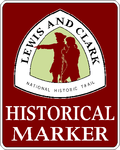
Standard. MoDOT shall provide signing for certified Lewis and Clark historic sites. Signing for sites shall direct motorists from the Lewis and Clark trail to the certified historic site. Signing for a certified site shall be limited to the nearest junction on the trail to the site. Second and third order signing on the trail shall not be allowed. Along the Mississippi River, where there is not an official Lewis and Clark trail, signing shall be provided from the “pseudo-trail” as designated by MoDOT.
Signing shall consist of the Lewis and Clark Historical Marker (M17-2a) sign and an appropriate Advance Turn Arrow placed in advance of the junction where motorists leave the trail. If additional trailblazers on the state system are required, the Lewis and Clark Historical Marker sign with the appropriate Advance Turn Arrow shall be used.
Additional trailblazing off the state system may be required to reach the certified historic site. This signing shall consist of the smaller version of the Lewis and Clark Historical Marker (M17-2a) sign, which is installed and maintained by others. MoDOT shall manufacture the Lewis and Clark Historical Marker signs with the cost of manufacturing reimbursed according to the following subarticles. Signing on the state system shall not be allowed unless the appropriate trailblazer signs off the state system are also installed, if required.
If a Public Area Directional sign does not exist for the facility, signing shall be provided according to the normal Lewis and Clark historic site policy.
Trailblazers shall be reimbursed by the appropriate state agency.
Requests for Lewis and Clark historic signing for a non-state owned location shall only be considered if the location has been certified by the National Park Service. Signing for certified sites shall be in accordance with the normal Lewis and Clark historic site policy. The owner of the site shall be responsible for the cost and installation of the trailblazer signs and securing approval from the appropriate local agencies for locating and maintaining the trailblazer signs.
Guidance. The Missouri Department of Natural Resources and the Missouri Department of Conservation have erected special interpretive signs at some of their sites. The advance signs for these sites should be incorporated into any signing that currently exists for the facility by adding it above the existing Public Area Directional sign (see assembly above).
The Lewis and Clark Historical Marker sign should be mounted to either the left or right side of the Public Area Directional sign based on the turn required to reach the site.
Support. Information for certification can be found at:
- Lewis & Clark National Historic Trail
- 1709 Jackson Street
- Omaha, NE 68102-2571
- or at www.nps.gov/lecl/parkmgmt/site-certification.htm.
Information regarding the trail in Missouri can be found at:
- The Missouri Lewis and Clark Bicentennial Commission
- 100 Jefferson Street, Suite 200
- Jefferson City, MO 65101
- 573-522-9019
- or at www.dnr.mo.gov/parks/lewisclark.htm.
Signing for certified sites will normally be from the approved Lewis and Clark trail. There are, however, several sites along the Missouri River in the north part of St. Louis County that are not conveniently located near the Lewis and Clark trail. Signing for a certified historic site located from the I-64 bridge over the Missouri River to its confluence with the Mississippi River will be allowed signing at an interchange along I-270 or I-64. Any signing provided along these routes will be in accordance with the normal Lewis and Clark historic site policy.
903.9.23 Historical Site Signs
Support. Historical sites, buildings, or district may be signed at the expense the facility.
Standard. To qualify for signing the historical site, building, or district shall meet the criteria of EPG 903.8.37 Traffic Generator Signing, EPG 903.11.3 Logos or EPG 903.12 TODS. Signing shall not be permitted where a commercial or recreational concessionaire serve as the primary activity or attraction. Minor concessionaire serving refreshments to the visitors shall not be considered the primary activity or attraction. No signing shall be provided for any individual site, building or event located within a larger signed area. The facility shall pay a participation fee for the signs.
Support. Historical sites, buildings or places that have “national prominence” and are “nationally known” may be signed at the Commission’s expense provided they meet the following criteria. Table 903.9.23 shows the list of sites that are considered to have “national prominence” and are “nationally known”.
Table 903.9.23 National Known, National Prominent Sites
| Non-contractual Sites |
|---|
| Daniel Boone's Home |
| General Pershing's Boyhood Home |
| George Washington Carver Nat'l Monument |
| Harry S Truman's Birthplace |
| Mark Twain's Birthplace |
| Route 66 State Park |
| Scott Joplin House |
| Trail of Tears State Park |
| Ulysses S. Grant National Historic Site |
| Wilson's Creek National Battlefield Park |
| Winston Churchill Memorial |
Standard. To qualify for signing the historical site, building, or place shall be listed in the National Register of Historical Places, open to the general public during normal hours, public owned or non-profit foundation owned and operated. Signing shall not be permitted where a commercial or recreational concessionaire serve as the primary activity or attraction. Minor concessionaire serving refreshments to the visitors shall not be considered the primary activity or attraction. MoDOT shall provide a maximum of second order signing. No signing shall be provided for any individual site, building or event located within a larger signed area.
For purposes of interpretation of this policy “national prominence” and “nationally known” persons, places, or events shall include but not be limited to the following: presidents, writers, battlefields, generals, educators and landmarks of national historical significance. Table 903.9.23 shows the list of sites that qualifies for signing.
903.9.24 Blue Star Markers (TR42-4)

Option. Blue Star Markers may be placed on the following routes: Route 36, Route 50, Route 67, I-44 and I-70. These signs are normally located in a rest area or roadside park. These signs are provided and maintained by others.
Standard. Approval for signing shall be obtained from the National Garden Clubs, Inc. prior to the erection of any new signs.
903.9.25 State Historical Society Markers
Support. On November 1952, the Commission entered into an agreement with the Missouri Historical Society for the erection of markers along the highways of Missouri at points of great historic interest. These signs are provided by others, normally in a rest area, roadside park or at a specific location of historical interest.
903.9.26 Local Reference/Community Awareness Signs
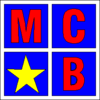 |
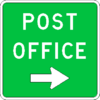 |
 |
 |
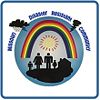 |
 |
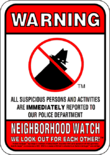 |
Option. Signing may be allowed on collector type roads that would not be considered appropriate for freeway/expressway roads. Local reference signs not described in EPG 903 Highway Signing may be considered for conventional type roads. Examples are signing for libraries, recycling centers, local parks, etc.
Cities and counties are permitted to provide directional signing to the city hall or courthouse. The sign location should provide the most direct route to the city hall or courthouse.
Guidance. Local reference signs and posts should be provided, installed, and maintained by the local political entity, and the district should approve all locations. Sign design for local reference signs should follow the principles of the MUTCD and EPG 903 Highway Signing for size, color and reflectorization.
Local reference signs are not to be allowed on interstates without approval from the State Traffic Engineer.
Supplemental or trailblazing signing for the city hall or courthouse over city or county streets should be the responsibility of the local jurisdiction. Only first order signs on conventional routes should be allowed. The city or county should provide the signing installation and maintenance at approved locations as determined by district personnel. The sign should meet our specifications and have reflective green background, white legend and border.
Traffic Division should approve any local reference signing.
Local reference and community awareness signs should have a maximum height and width of 24 inches.
Support. Many communities participate in programs sponsored by different agencies or groups. Some of these programs provide signs that the cities want to post to acknowledge their participation. Signing for the following programs are approved for installation on right of way.
1. The National Weather Service sponsors the storm ready program. Communities that qualify for the program are provided signs by the program. MoDOT will allow Storm Ready signing to be placed adjacent to city limit signs.
2. The disaster resistant community program is sponsored by FEMA and locally coordinated by the SEMA. Communities that qualify for the program are provided standard signs by the program. MoDOT will allow DISASTER RESISTANT COMMUNITY signing to be placed adjacent to city limit signs.
3. Communities will be eligible for the Missouri Community Betterment signs when they become an active member in the Missouri Community Betterment Program and will lose their eligibility if they become inactive for more than one year.
4. MoDOT will allow TREE CITY U.S.A. signs to be placed adjacent to city limit signs. The National Arbor Day Foundation sponsors the Tree City U.S.A. program for a year at a time. Upon meeting the requirements for the program a sign or signs are provided to the city.
5. MoDOT will allow Neighborhood Watch signs to be placed at the right of way line.
6. Mothers against drunk driving, MADD, sponsors a community recognition program. MADD provides signs to the communities that qualify for signing. We will allow MADD signing to be placed adjacent to city limit signs.
7. MoDOT will allow DARE signing to be placed adjacent to city limit signs and
Standard. Community awareness signs shall not detract from MoDOT signs and maintenance of the roadway. The signs shall look professional, not contain advertising of any kind, shall be limited to 2 posts with 2 signs per post and be located near the city limits sign.
The Storm Ready signs shall be erected on a separate post, to be maintained by the city. Signs and signposts shall be furnished, installed and maintained by the participating community.
DISASTER RESISTANT COMMUNITY signs shall be erected on a separate post, to be maintained by the city. Signs and signposts shall be furnished, installed and maintained by the participating community.
The Missouri Community Betterment (I-15) signs shall be placed in the upper left hand corner of the city limit signs of eligible communities. The signs shall be 12 in.x 12 inches. Communities shall be charged a fee for the cost, erection, and maintenance of each sign.
Communities shall petition the Department of Economic Development for the signs. The Department of Economic Development shall request MoDOT to erect the signs, collect fees from the communities for the erection of these signs with checks made payable to the Director of Revenue - Credit State Road Fund, and be responsible for maintenance and replacement of worn, faded, or damaged signs.
The Department of Economic Development through the office of the Missouri Community Betterment Program shall be responsible for certifying the eligibility of a community for the Missouri Community Betterment Signs, request the Missouri.
To obtain a TREE CITY U.S.A. sign city must supply documentation by submitting a copy of their approved application to the district office for the present year. This must be done each year in order for the signs to remain next to the city limit signs.
TREE CITY U.S.A. and Neighborhood Watch signs shall be erected on a separate post, to be maintained by the city or others. Signs and signposts should be furnished, installed, and maintained by the participating community.
Option. Where there is a need for several of these awareness signs to be installed at a particular location they may be combined into an assembly with a maximum of two awareness signs per post and two posts per location.
If there is not room to place the DISASTER RESISTANT COMMUNITY, Missouri Community Betterment, TREE CITY U.S.A., MADD, or DARE sign next to the city limit sign they may be located 200 ft. downstream from the city limit sign. Counties participating in the storm ready program may have signs installed adjacent to county line signs with requirements similar to city installations. Any year beyond the first year a decal may be attached to the Tree City U.S.A. sign.
DARE signs may also be located at the right of way line on routes that pass along school properties. Counties participating in the DARE program may have signs installed adjacent to county line signs with requirements similar to city installations.
Guidance. Bus stops should not be permitted on freeways and should be established only with the approval of the District Engineer.
The location and spacing of the stops shall be consistent with both the needs of the bus passenger and a desirability of minimizing traffic flow disruption and operational hazards. Where bus stops are located at intersections, every effort should be made to place them on the far side unless operational considerations clearly indicate otherwise. Every effort should be made to locate the bus stops off the traveled portion of the roadway.
The shoulder width should be sufficient to allow clearance between the parked bus and the pavement and also permit storage of passengers and loading of the bus.
Signing for bus stops should be performed by municipality forces with standard red on white "No Parking - Bus Stop" signs following enactment of an enabling ordinance either on a blanket or specific location basis.
No other bus system signing, such as trail blazing for bus routes, should be permitted on the state system.
Option. Where a special need exists, the shoulder may be improved for safety and maintenance reasons.
Local bus officials may be permitted to install supplementary plates bearing schedules for the particular stop and other information relating to the bus operation. Distinctive bus system logos may be permitted on the supplementary signs provided they are of a configuration, which will not prove distracting to motorists. These supplementary signs should be installed beneath the municipality signs.
Signing for other mass transit systems, including park and ride lots associated with the system, will be allowed under guidelines similar to bus stops.
If the mass transit system has a logo they may incorporate it in to their sign.
903.9.27 School Awareness Signs
 |
 |
Support. Signs stating THIS IS A DARE DRUG FREE SCHOOL ZONE will be allowed at the right of way line on routes that pass along school property.
A channel type post is recommended for the installation of the school awareness signs.
Standard. DARE signs shall be erected on a separate post, to be maintained by the city.
In conjunction with Missouri Statues (RSMo 195.214) that addresses distribution of controlled substances near schools, one DRUG FREE SCHOOL ZONE sign shall be allowed per direction at the right of way line on routes where the right of way adjacent to school properties. Schools wishing to erect these signs shall contact the district office prior to installation.
Signs and signposts for the THIS IS A DARE FREE SCHOOL ZONE and DRUG FREE SCHOOL ZONE shall be furnished, installed and maintained by the participating community. Each sign should be installed 1,000 ft. from the end of school property.
Guidance. The school should be informed of the importance of contacting utility companies since the sign will likely be in the utility corridor.






